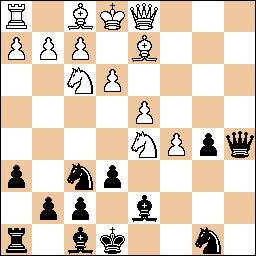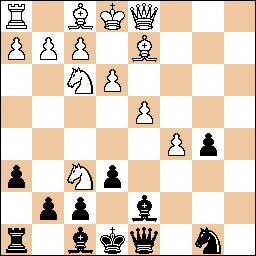Saturday, July 09, 2005
Question for Tempo and Mousetrapper (and Anyone Else Who's Game)
I have been asking myself several questions about scanning recently:
- Can a scan force you to see moves that do not just pop out on their own?
- Does scanning work effectively on defense?
- Where do you draw the line between scanning and calculation for decision making?
I was wondering if you guys could use your scan methods to take a look at a couple of positions, treating the situation like you are Black in a standard game and are using around 5 minutes per move. I was looking over a game I won and realized how tough some of these positions were was had I been playing the other side. I have my "scan" and move choice after the pics.
-=-=-=-=-
Black to Move

Black to Move
-=-=-=-=-
Hanging List:
White: Rh1, Nd5
Black: Qa5, Rh8, Nb8
Checks, Captures, and Threats:
White Checks: Nxf6+ and Nc7+. Nc7+ may seem awful, but if the Black Queen abandons the d8-a5 diagonal it forks the King and the now outnumbered b5 pawn.
White Captures: obviously Bxa5 wins the Queen, although if it were white to move Nxf6+ first gets the Knight off-prise with tempo, destroys Black's only well developed piece, and essentially converts to a more overwhelming material advantage. White has pressure on the b5 pawn but Bxb5 appears unsound.
White Threats: I don't see much of any additional threats except possibly Ne5, threatening the Bishop on d7 and weakening b5.
Black Checks: Qd2+?? is met by either Nxd2 or Qxd2, although it does allow Nxd5 or exd5
Black Captures: Nxd5?? or exd5?? both lose the Queen.
Black Threats: I see very little in the way of threats beyond Qa8 or Qa2, ganging up on the Knight. Arguably b4 parries a threat and pushes a passed pawn, but the Knight on d5 also controls that square, making for ...b4 Bxb4.
I would see candidate moves as Qd8, Qa4, and Qa2. Qa4 looks a failed attempt to hold on to the pawn and possibly invites Nc3 and Nb6. Qa2 seems rather loose but is the most attractive to me, desperately holding on to the b pawn promotion threat by guarding the b1 square. Qa2 puts pressure on the Bishop on d2, too. Qd8 seems like undeveloping, but looks like better defense as it protects both Knights.
After ...Qd8 Nxf6+
Hanging List:
White: Rh1, Nf6
Black: Rh8
Checks, Captures, and Threats:
White Checks: Nxf6+ was the last move, and I don't see any follow up checks or mate threats.
White Captures: White has pressure on the b5 pawn, but Bxb5 still appears unsound.
White Threats: I have already looked at this game so it's difficult for me to not know what I played next. As Black I would guess that 70% of the time I wouldn't see any additional threats, and 30% of the time I would notice that Qb1 and Qb3 outnumber b5.
Black Checks: None.
Black Captures: Qxf6, gxf6
Black Threats: Qxf6 doesn't seem to threaten much, but it does hang the Knight on b8. gxf6 gives Black's rook an open file at the cost of doubling pawns and weakening f6.
I would lean towards gxf6. The game continued
...Qxf6 Bxb5! Bxb5 Qb1 and White is skewering 2 Black minor pieces.
Fritz had some different opinions about the whole thing:
1. +- (2.99): 14...Qa7 15.Nb6 Be7 16.Nxd7 Qxd7 17.Qb3 0-0 18.Bxb5 Qc7 19.0-0 Nc6 20.Ra1
2. +- (3.09): 14...Qd8 15.Nxf6+ gxf6 16.Qb3
3. +- (3.15): 14...b4 15.Bxb4 Qd8 16.Nxf6+ gxf6 17.e4 Bc6 18.Bd3 Bg7 19.0-0 0-0 20.Bc3
4. +- (3.39): 14...Qa4 15.Nb6 Qa6 16.Nxd7 Nbxd7 17.Qb1 Be7 18.Bxb5 Qc8 19.0-0 0-0
...Qa7 15.Nb6 was surprising, and my Qa2 was rated at +- (4.30).
1. +- (3.06): 15...gxf6 16.Qb3 Bg7 17.Bxb5 0-0 18.e4 Bc6 19.Bxc6 Nxc6 20.d5 f5 21.dxc6 fxe4 22.Ng1
2. +- (3.81): 15...Qxf6 16.Ne5 Bxc5 17.Nxd7 Nxd7 18.dxc5 0-0 19.c6 Nb8 20.Bxb5
Interestingly after Qf6 the sacrifice Bxb5 gives up .21 pawns worth of advantage.
White Captures: obviously Bxa5 wins the Queen, although if it were white to move Nxf6+ first gets the Knight off-prise with tempo, destroys Black's only well developed piece, and essentially converts to a more overwhelming material advantage. White has pressure on the b5 pawn but Bxb5 appears unsound.
White Threats: I don't see much of any additional threats except possibly Ne5, threatening the Bishop on d7 and weakening b5.
Black Checks: Qd2+?? is met by either Nxd2 or Qxd2, although it does allow Nxd5 or exd5
Black Captures: Nxd5?? or exd5?? both lose the Queen.
Black Threats: I see very little in the way of threats beyond Qa8 or Qa2, ganging up on the Knight. Arguably b4 parries a threat and pushes a passed pawn, but the Knight on d5 also controls that square, making for ...b4 Bxb4.
I would see candidate moves as Qd8, Qa4, and Qa2. Qa4 looks a failed attempt to hold on to the pawn and possibly invites Nc3 and Nb6. Qa2 seems rather loose but is the most attractive to me, desperately holding on to the b pawn promotion threat by guarding the b1 square. Qa2 puts pressure on the Bishop on d2, too. Qd8 seems like undeveloping, but looks like better defense as it protects both Knights.
After ...Qd8 Nxf6+
Hanging List:
White: Rh1, Nf6
Black: Rh8
Checks, Captures, and Threats:
White Checks: Nxf6+ was the last move, and I don't see any follow up checks or mate threats.
White Captures: White has pressure on the b5 pawn, but Bxb5 still appears unsound.
White Threats: I have already looked at this game so it's difficult for me to not know what I played next. As Black I would guess that 70% of the time I wouldn't see any additional threats, and 30% of the time I would notice that Qb1 and Qb3 outnumber b5.
Black Checks: None.
Black Captures: Qxf6, gxf6
Black Threats: Qxf6 doesn't seem to threaten much, but it does hang the Knight on b8. gxf6 gives Black's rook an open file at the cost of doubling pawns and weakening f6.
I would lean towards gxf6. The game continued
...Qxf6 Bxb5! Bxb5 Qb1 and White is skewering 2 Black minor pieces.
Fritz had some different opinions about the whole thing:
1. +- (2.99): 14...Qa7 15.Nb6 Be7 16.Nxd7 Qxd7 17.Qb3 0-0 18.Bxb5 Qc7 19.0-0 Nc6 20.Ra1
2. +- (3.09): 14...Qd8 15.Nxf6+ gxf6 16.Qb3
3. +- (3.15): 14...b4 15.Bxb4 Qd8 16.Nxf6+ gxf6 17.e4 Bc6 18.Bd3 Bg7 19.0-0 0-0 20.Bc3
4. +- (3.39): 14...Qa4 15.Nb6 Qa6 16.Nxd7 Nbxd7 17.Qb1 Be7 18.Bxb5 Qc8 19.0-0 0-0
...Qa7 15.Nb6 was surprising, and my Qa2 was rated at +- (4.30).
1. +- (3.06): 15...gxf6 16.Qb3 Bg7 17.Bxb5 0-0 18.e4 Bc6 19.Bxc6 Nxc6 20.d5 f5 21.dxc6 fxe4 22.Ng1
2. +- (3.81): 15...Qxf6 16.Ne5 Bxc5 17.Nxd7 Nxd7 18.dxc5 0-0 19.c6 Nb8 20.Bxb5
Interestingly after Qf6 the sacrifice Bxb5 gives up .21 pawns worth of advantage.
1. +- (3.55): 16.Ne5 Bxc5 17.Nxd7 Nxd7 18.dxc5 0-0 19.c6 Ne5 20.Bxb5 Rc8 21.0-0 Nxc6 22.Qf3
2. +- (3.54): 16.Qc2 Qd8 17.Ne5 Qc7 18.Be2 Bd6 19.Nxd7 Nxd7 20.Bxb5 Be7 21.Qa4
3. +- (3.36): 16.Bd3 Qd8 17.Ne5 Be7 18.0-0 0-0 19.Qf3 Be8 20.Ra1 f6
4. +- (3.34): 16.Bxb5 Bxb5 17.Qb3 Bc6 18.Qxb8+ Qd8 19.Qxd8+ Kxd8 20.Ne5 Be8 21.e4 f6 22.Ba5+
2. +- (3.54): 16.Qc2 Qd8 17.Ne5 Qc7 18.Be2 Bd6 19.Nxd7 Nxd7 20.Bxb5 Be7 21.Qa4
3. +- (3.36): 16.Bd3 Qd8 17.Ne5 Be7 18.0-0 0-0 19.Qf3 Be8 20.Ra1 f6
4. +- (3.34): 16.Bxb5 Bxb5 17.Qb3 Bc6 18.Qxb8+ Qd8 19.Qxd8+ Kxd8 20.Ne5 Be8 21.e4 f6 22.Ba5+
That doesn't take into account that the sacrifice's shock value has got to be at least .3 pawns.
-=-=-=-=-
TCT Results | Circle 1 | Circle 2 |
| Step 1 | 97% | 99% |
| Step 2 | 93% | 96% |
| Step 3 | 93% | *97% |
| Step 4 | 80% | ??% |
| Step 5 | 74% | ??% |
Comments:
<< Home
This is very well thought out and annotated. I will study it more when less pressed for time. I look forward to reading what the scanners think about it. An interesting thread.
For me the real difficulty is the second position. While it seems like a simple choice between 2 moves, my "each move" scan would still miss the Bishop sacrifice on b5 threat and probably Qb1/Qb3.
Maybe the Bishop sacrifice should be something will be one of those pop-out moves. It certainly popped out as White after ...Qxf6. Somehow defensively it's much harder for me to see. It's partially a visualization difficulty I think.
Maybe the Bishop sacrifice should be something will be one of those pop-out moves. It certainly popped out as White after ...Qxf6. Somehow defensively it's much harder for me to see. It's partially a visualization difficulty I think.
Can a scan force you to see moves that do not just pop out on their own?
As I see things now, the scan helps you to trigger the pop out of patterns. Usually I look at the board and something is drawing my attention. That is: automatically pops out. The scan is intended to cover all area's of the board, so maybe more patterns pop out. If you are not very familiar with a pattern, it doesn't pop. As was the case with you with the Bxb5 sacrifice. The scan helps you to reveal the vulnerability of Nb8. If that doesn't trigger the popping out of the skewer pattern, nothing will. So it's no panacee.
Does scanning work effectively on defense?
It works on both defence and attack. My problem is that due to doing much problems from the attacking side, my ability to spot combinations against me is underdeveloped. That's a pattern problem, so it's not gonna be fixed by scanning (besides that scanning forces me to have a look at my own side).
Where do you draw the line between scanning and calculation for decision making?
First there is scanning, then some patterns are triggered to pop out, then you have to calculate if everything is ok when trying to make use of this original idea. So calculation will make you decide.
Post a Comment
As I see things now, the scan helps you to trigger the pop out of patterns. Usually I look at the board and something is drawing my attention. That is: automatically pops out. The scan is intended to cover all area's of the board, so maybe more patterns pop out. If you are not very familiar with a pattern, it doesn't pop. As was the case with you with the Bxb5 sacrifice. The scan helps you to reveal the vulnerability of Nb8. If that doesn't trigger the popping out of the skewer pattern, nothing will. So it's no panacee.
Does scanning work effectively on defense?
It works on both defence and attack. My problem is that due to doing much problems from the attacking side, my ability to spot combinations against me is underdeveloped. That's a pattern problem, so it's not gonna be fixed by scanning (besides that scanning forces me to have a look at my own side).
Where do you draw the line between scanning and calculation for decision making?
First there is scanning, then some patterns are triggered to pop out, then you have to calculate if everything is ok when trying to make use of this original idea. So calculation will make you decide.
<< Home



